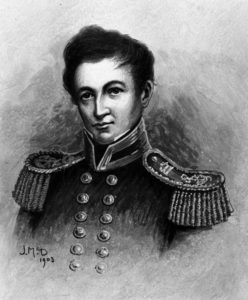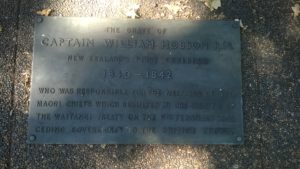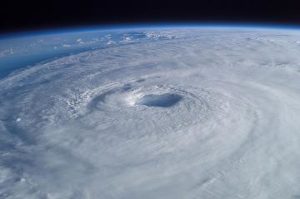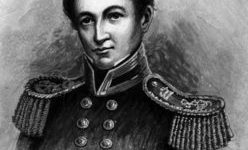1842: Death of Hobson
September 10, 2019
By AHNZ
 Today in history, 10 September, 1842: Governor Hobson died in office from a cerebrovascular accident (stroke.) You’ll find his remains in a public tomb beside the city-side of Grafton Bridge, Auckland. It reads..
Today in history, 10 September, 1842: Governor Hobson died in office from a cerebrovascular accident (stroke.) You’ll find his remains in a public tomb beside the city-side of Grafton Bridge, Auckland. It reads..
“THE GRAVE OF CAPTAIN WILLIAM HOBSON R.N. NEW ZEALAND’S FIRST GOVERNOR…WHO WAS RESPONSIBLE FOR THE MEETING OF THE MAORI CHIEFS WHICH RESULTED IN THE SIGNING OF THE WAITANGI TREATY ON THE 6TH FEBRUARY 1840 CEDING SOVEREIGNTY TO THE BRITISH CROWN”
 Actually, Hobson was not the first Governor of New Zealand at all. Major Sir George Gipps of New South Wales came earlier with the same job title. The ever-expanding Australia had a New Zealand problem on its doorstep, a threat to their political and economic control in the region.
Actually, Hobson was not the first Governor of New Zealand at all. Major Sir George Gipps of New South Wales came earlier with the same job title. The ever-expanding Australia had a New Zealand problem on its doorstep, a threat to their political and economic control in the region.
Annexation of New Zealand
 The townsfolk of Kororareka, Bay of Islands, were taken by surprise when Hobson arrived.¹ Quickly making moves to take over, Hobson blew his budget buying land for a capital at the Bay of Islands but soon abandoned it for Auckland. Bringing New Zealand’s first taxman with them, the Hobson Gang was going broke and needed to steal some money to survive. The first idea to boot up The State in this country and get rich was to nullify all the land titles up to that point, neatly disenfranchising the free people of New Zealand. Settlers were forced to re-purchase their land through the State and Hobson would get his cut. The Maoris were able to sell the same land twice over and be paid a second time. The free folk who had already established a colony at Port Nicholson were furious at the parasitical predation but what could they do? They were out-gunned by the man they called “Captain Crimp,” who cramped their efforts to survive and make a go of their new endeavour.
The townsfolk of Kororareka, Bay of Islands, were taken by surprise when Hobson arrived.¹ Quickly making moves to take over, Hobson blew his budget buying land for a capital at the Bay of Islands but soon abandoned it for Auckland. Bringing New Zealand’s first taxman with them, the Hobson Gang was going broke and needed to steal some money to survive. The first idea to boot up The State in this country and get rich was to nullify all the land titles up to that point, neatly disenfranchising the free people of New Zealand. Settlers were forced to re-purchase their land through the State and Hobson would get his cut. The Maoris were able to sell the same land twice over and be paid a second time. The free folk who had already established a colony at Port Nicholson were furious at the parasitical predation but what could they do? They were out-gunned by the man they called “Captain Crimp,” who cramped their efforts to survive and make a go of their new endeavour.
To make a buck, The Hobson Gang resorted to putting customs duties on trade goods. As with the land theft racket, this caused a mass of confusion and Dead Weight economic cost to the host population for little returns to The Gang. Most of the tax burden fell on Maoris and the efforts to escape Hobson’s enforcers created our first smuggling industry.
A Sick Dying Governor
Hobson was an invalid during most of his term in New Zealand leading up to his fatal attack. A series of strokes made him paralysed, unable to write or speak normally. This gave opportunity for his henchman, Willoughby Shortland, to make a pain of himself. These years in Auckland were a tense and dull, toxic, environment with petty duelling and the pall of a sick, dying, Governor hanging over them.
 Even if Hobson were fit, he and his Gang were Honour Culture men and dying out anyway. What was required to run a mafia racket of New Zealand was a manager but Hobson was a commander. The Captain was used to being able to order people to do things and flog or kill them if they didn’t obey. How could he juggle Maori tribes, money troubles, French colonists, The Kororareka Association, Port Nicholson Settlers’ Council, Missionaries, Smugglers, Warlords, gun-runners?
Even if Hobson were fit, he and his Gang were Honour Culture men and dying out anyway. What was required to run a mafia racket of New Zealand was a manager but Hobson was a commander. The Captain was used to being able to order people to do things and flog or kill them if they didn’t obey. How could he juggle Maori tribes, money troubles, French colonists, The Kororareka Association, Port Nicholson Settlers’ Council, Missionaries, Smugglers, Warlords, gun-runners?
Hobson’s first New Zealand apopleptic attack occurred on Auckland Harbour on 1 March 1840. While looking for a site for his next capital, Auckland, a massive tropical cyclone passed over. “Its centre must have passed between the Bay of Islands and the river Thames,” reports commander Charles Wilkes. To Hobson, bobbing about on The HMS Herald, the storm must have resembled the violent mental strains he was under. When the attack and the storm have passed, Hobson was left paralytic on his right side which effected his ability to write and speak.
At noon, 10 September 1842, Hobson suffered his final attack and died. The remains of The Hobson Gang broke up and dispersed, broken on the rocks of a domesticated but untamed New Zealand not yet ready for Statism. Sadly, others would come to finish what Hobson had begun.
—
1 Ref. Visiting American explorers; Wilkes (1843)
Image ref. Hobson’s grave; AHNZ Files (2019)
 Like Comment Share
Like Comment Share





